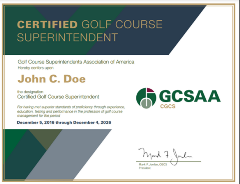

This region includes Alaska, Colorado, Idaho, Montana, Oregon, Utah, Washington and Wyoming
A former superintendent, David spent more than 20 years in the golf course management industry before joining the GCSAA staff. He resides in Oregon City, Ore.
Tel. 800-472-7878, ext. 3608.; dphipps@gcsaa.org

The famous philosopher, Heraclitus, once said, “The only thing that is constant is change.” With that said, change brings new opportunities and new opportunities bring growth. The GCSAA Certification Committee felt the same way as they took a close look at our existing certification program. Like most successful programs, as they grow, they need to evolve to meet the changing times. This was the approach as they decided to make some changes to modernize the program. The intent was to keep the high standards of the certification process while reducing the amount of time necessary to complete it.
There is no denying it, the GCSAA certification program is not for the faint of heart. It has been regarded as one of the most robust certification programs in our industry and those who have passed it have truly stood up to the rigors of the program. Stephanie Confer, GCSAA’s certification manager, told me, “I don’t have the exact percentage on this, but looking back it looks like only 25-30% of individuals who purchased the portfolio completed the certification process.” With the new changes to the program, now may be the right time to get started.
To review what has changed, let’s look at the old criteria.
First, to be eligible for the program the applicant must have met the eligibility requirements of specific levels of education and experience. In other words, meet the Class A requirements. In addition, the applicant must have possessed a current pesticide license or have passed the GCSAA IPM exam.
Second, the applicant must have completed the online GCSAA self-assessment.
Third, the applicant must have completed a portfolio.
Lastly, the applicant must have completed the proctored, paper-based exam and attesting of the golf course. Renewal requirements followed.
The new program is similar in several aspects. The applicant still must meet Class A criteria and possess a pesticide license or pass the IPM exam to apply. There continues to be an attesting component and an exam. And, the renewal criteria remain the same.
What is different:
The new Leadership & Communication component of the program gives options in which to complete. You will be required to provide proof of three out of the four following activities:
The attesting process is to be enhanced, with a scoring rubric incorporated for consistency in grading. The 2021 Certification Committee is currently working through this process with Dr. Thayn. Attesting content will be reviewed and structured in a way that lends itself to providing better direction to the attestors for grading. This process will be completed and ready for the next growing season for most.
There are a few additional enhancements to the program to make you aware:
I am by no means an expert on this program since I am not a certified superintendent, but I can certainly attest that the work that has gone into making this a more time-efficient, yet accountable, program. We can all be grateful to the staff at GCSAA and those who have served on the certification committee over the years for adapting and changing our certification process to meet the needs of today’s superintendent. Our program remains the standard in which all others are measured.
Please feel free to reach out to Stephanie Confer anytime for CGCS related questions. She is happy to help! sconfer@gcsaa.org
David Phipps
GCSAA
Upcoming events in the region.